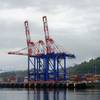Norway's Statoil has called upon shipbuilder Kleven Verft to construct a pair of 309-ft. (94.3-m) supply ships that will run on LNG. The vessels, which are scheduled for completion during 2003, and operated by Statoil, will be contracted from Eidesvik and Møkster Shipping. According to Knut Barland, Statoil's vice president for Environment, the LNG power concept is expected to cut the vessels' nitrogen oxide (NOx) emissions by 85 percent; annual emissions are expected to be lowered by 420 tons.
Why would a company knowingly add $6 million to the construction price of a new vessel, and more than $1 million per year in operating costs? The answer is a multi-faceted one, but basically it comes down to environmental responsibility. Known as the first operator on the Norwegian continental shelf to feature LNG powered propulsion on its vessels, Statoil said that a driving force behind its decision to go with LNG power was two-fold — the company wanted to employ a pair of vessels that would be environmentally sensitive — while building upon new technology. While the vessels are more expensive to build and operate, they also tremendously reduce emissions, a savings that can be distributed into the company’s overall operations.
According to Barland, the Norwegian government has allowed Statoil to credit the NOx reduction against land-based entities. "Reductions achieved in one place, can be used in other places," Barland said. He's referring to myriad of projects that Statoil is currently involved in, which includes two 400 MW gas-fired stations located in Kaarstoe and Kollsnes. The plants, which are part of a deal that involves Statoil, Norsk Hydro and Statkraft, are an issue with the Norwegian Government, according to Barland, because of their carbon dioxide CO2 emissions. Per the government, refineries must hold NOx emissions down to five parts per million (ppm), which according to Barland, is an expensive task. The reasoning behind this, he adds, is to curb the acid rain problem that is prevalent on the Norwegian continental shelf.
So instead of taking the conventional route, Statoil approached the Norwegian Government with its idea for the LNG-powered vessels, and upon its approval, the innovation/creative process was begun. The task of bringing the innovative vessels to fruition has involved not only Statoil, but Eidesvik, who is chartering the vessels, as well as Kleven Verft, the Norwegian shipyard that has been designated as the builder.
So far, according to Eidesvik's administration director, Nils Himle, the production process is one of trial and error. "One of the challenges of this project is making the rules as you go along," Himle said. "Since this (the construction of LNG-powered ships) has never been done before, there are no guidelines that have already been established." Himle added that the company, along with both the Norwegian Government and Det Norske Veritas, is working to formulate a set of guidelines in hopes that this project is a blueprint for future LNG-powered vessel projects.
The 4,400-gt vessels will have an overall length of 311 ft. (94.9 m), a breadth of 67 ft. (20.4 m) and design draft of 25 ft. (7.5 m), and will operate at a service speed of 16 knots. According to Himle, they will be larger than most supply vessels as more capacity than usual will be taken up by the LNG tanks, which when backed up by diesel fuel, will hold 1,000 cu. m. Water ballast capacity is 2,000 cu. m. and deck cargo capacity checks in at 2,500 tons.
Upon their scheduled 2003 completion, the vessels, which will operate from the Coast Center Base near Bergen, will supply oil and gas installations in the Tampen area of the North Sea.
Featured videos

Inmarsat Enhances Service to Drive Digitalization

Tracking Foreign Vessels Working in the U.S. Jones Act Market

Inside the Electrified Truckable Tug
Subscribe for
Maritime Reporter E-News
Maritime Reporter E-News is the maritime industry's largest circulation and most authoritative ENews Service, delivered to your Email five times per week









